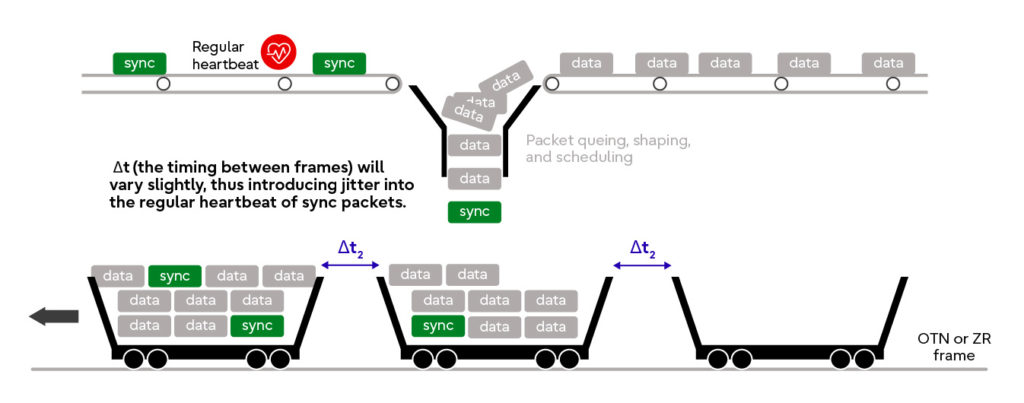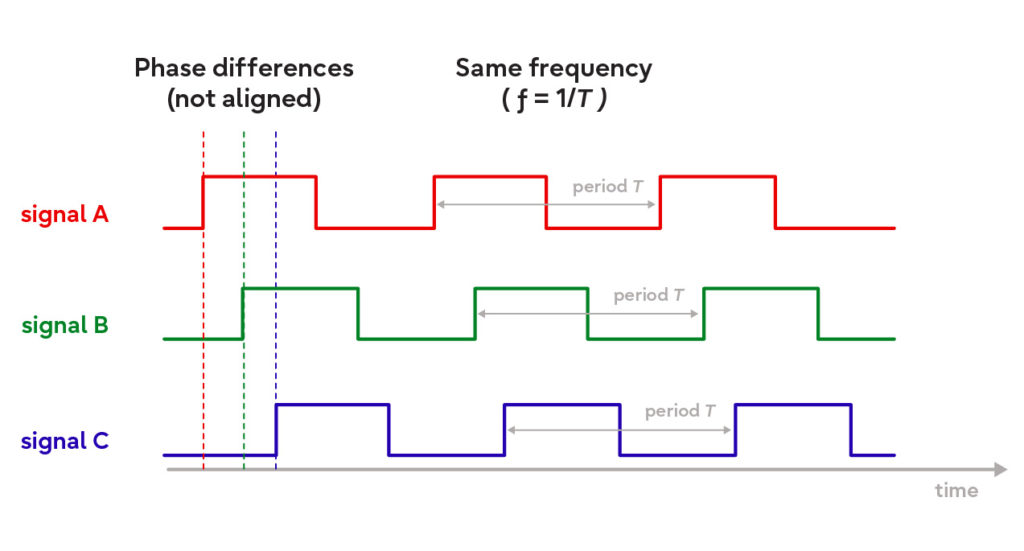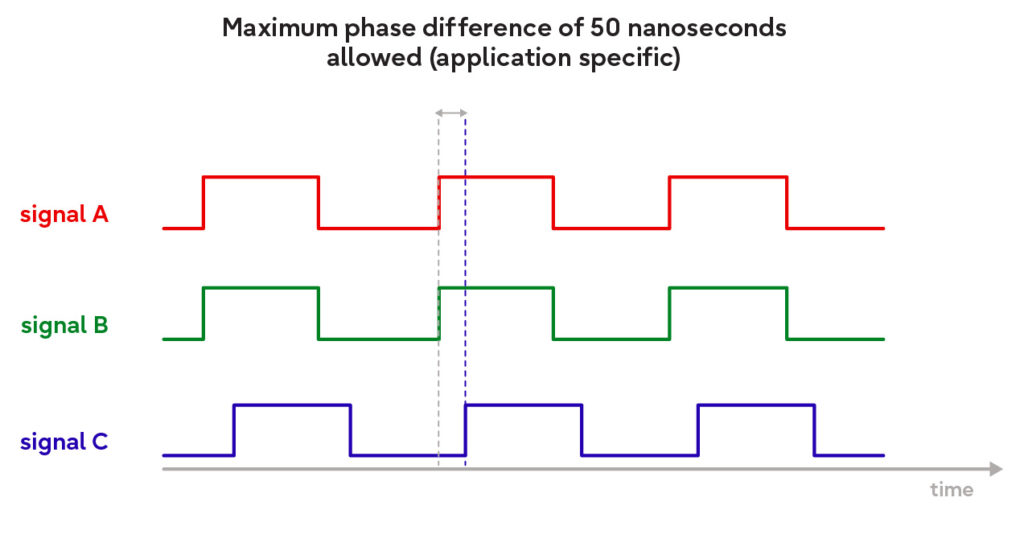
The first blog in this series focused on the resurgence of synchronization transport requirements in order to support the deployment of low latency, high reliability applications such as 5G and Time Sensitive Networking (TSN) applications.
What then are the requirements for transporting this new generation of synchronization reference signal across an optical network? The answer is relatively simple: the bar has been raised and the requirement for reference signal accuracy is much higher. The traditional method of transporting a reference timing signal within the overhead of the optical transport layer, such as SONET/SDH and OTN, is no longer guaranteed to be sufficient.
Let’s discuss the quality-of-service requirements which must be provided by the optical layer to ensure integrity of the synchronization reference signal throughout the network.
DWDM Transport Using OTN and ZR Mapping
Examples of network synchronization protocols include PTP (Precision Time Protocol, also known as IEEE 1588 v2), SyncE (Synchronous Ethernet), and NTP (Network Time Protocol). All three are transported over Ethernet. Packets with timing information are sent at regular intervals, like a heartbeat. The bandwidth required is very low, but variations in the regularity of when packets are received (known as jitter) must be kept to a minimum.
Traditional DWDM systems encapsulate Ethernet streams into successive asynchronous transport containers with their own transport overhead. There are two prevalent encapsulation formats. The first, in use for the last 20 years, is OTN which is summarized in the ITU G.709 standard. OTN provides a very flexible encapsulation method supporting Ethernet, SONET, Fiber Channel, TDM, etc… This flexibility comes at the cost of complexity and a large overhead. The second, the ZR standard, is more recent, optimized for Ethernet, and much simpler.
Latency & Jitter
The issue with these encapsulation standards is that they introduce additional latency as well as jitter. Latency is the delay introduced by the transport of a signal across the optical network. This latency is unavoidable and typically, the infrastructure has the ability to tolerate latency by compensating for it.
Jitter, sometimes referred to as packet delay variation, is more problematic as it is a measurement of the variation in latency. Asynchronous networks, as the name implies, are not synchronized at the network level and this will cause a variation in latency. By definition, jitter is not deterministic and this uncertainty does not allow the receiver to compensate for it and keep the network synchronized. One can visualize OTN and ZR encapsulation as a conveyor belt loading iron ore into freight containers on a train. Once the train is full, it leaves the station and the next one pulls in. Depending on the container fill rate and how the Ethernet stream is divided between the containers, this will create a variable delay at the receiving end. This is the definition of jitter.

Jitter Tolerance
The big question is how much jitter does OTN and ZR mapping structures create, and how much jitter can PTP, SyncE and NTP protocols tolerate? It turns out that each of these protocols have their own tolerance levels. Let’s look at them one by one.
Network Time Protocol (NTP)
This is the least stringent timing protocol. NTP periodically sends the date and time to every device in a network. It’s intended precision is a few milliseconds. Considering that the time error limit for both OTN and ZR is, at most, slightly larger than 1µs, neither encapsulation format will affect the accuracy of the NTP protocol. Use of OTN or ZR encapsulation methods for an NTP timing stream is considered safe as either of these protocols will not introduce an amount of jitter which can compromise the protocol’s accuracy.
Network Time Protocol (NTP) can be reliably be transported over a DWDM network using either OTN or ZR encapsulation and no special attention is required. This is good news.
Synchronous Ethernet
SyncE is a commonly used synchronization protocol which provides frequency synchronization on a node-by-node basis within an Ethernet network. The intent is to deliver a reference timing signal with a very accurate and consistent period between the heartbeats. These sequences of pulses are at the same frequency but their phase do not have to be aligned. This is represented in the picture below showing three different signals with the same frequency but different phases.

These three signals are frequency synchronized but not phase synchronized. This is the intention of Synchronous Ethernet – to provide frequency synchronization. It is sufficient to support LTE networks (but not 5G) as the required accuracy is in the range of parts per million (ppm).
This protocol is sufficiently resilient to be transported over OTN or ZR encapsulation and still remain of a high enough quality and reliability to support traditional LTE services.
This is the reason why so far, little attention was paid to the underlying transport technology used when transporting Synchronization Reference signals over a DWDM optical infrastructure. So far so good!
5G TDD & Precision Time Protocol (PTP)
The use of Time Division Duplexing (TDD) in 5G networks has drastically raised the bar for the accuracy of transported synchronization reference signals. A reliable 5G RAN infrastructure requires a distributed timing source which is both frequency and phase synchronized. Also, depending on the application, the phase difference has to kept below 50ns. This is represented in the figure below.
In this figure, PTP signals A and B are perfectly frequency and time synchronized while signal C is perfectly frequency synchronized, but has a phase offset compared to the two other reference signals.

It is this phase offset which has to be kept below a very small level. Another complexity is that PTP assumes that the transmit and receive paths between the source and destination are exactly of the same length, i.e. that that the roundtrip transmission time is evenly divided between the two directions.
The use of either OTN or ZR encapsulation over a traditional bi-directional fiber based DWDM architecture is not ideally suited for these stringent requirements for two reasons:
- The directional symmetry assumption is an issue. It is extremely rare that the transmission distance for both directions along a fiber path is exactly the same. For protection purposes, DWDM network spans use different cables for each direction, and they are often spaced apart from each other which results in different lengths.
Transmission time for a C-Band wavelength in an SMF cable is approximately 5µs per kilometer. This is by itself a small number but when compared to the very stringent PTP requirements, we can see that even a 1km fiber cable distance difference between the two directions will affect the accuracy of the PTP Timing Reference.
It is worth noting that this deficiency can typically be managed. Most PTP synchronization systems allow the user to pre-program a time offset to account for the difference in transmission time between the two directions. This workaround is not permanent as this offset continuously need to be reassessed every time a change is done to the DWDM network topology. - The jitter and maximum time error due to OTN and ZR encapsulation does not have any workaround. These encapsulation methods will introduce a time error which is an order of magnitude too large for PTP’s stringent requirements. We cannot therefore rely on either OTN or ZR encapsulation to reliably transport a PTP Synchronization Reference signal.
Now, this is bad news for DWDM transmission!
The next blog in this series will describe how Fujitsu’s 1FINITY Optical Networking Platform transports NTP, SyncE as well as PTP and provide a reliable transport of synchronization reference protocols over DWDM networks.